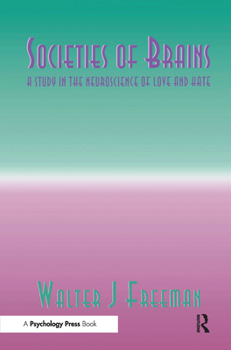Societies of Brains: A Study in the Neuroscience of Love and Hate
Select Format
Select Condition 
Book Overview
This monograph from a leading neuroscientist and neural networks researcher investigates and offers a fresh approach to the perplexing scientific and philosophical problems of minds and brains. It explains how brains have evolved from our earliest vertebrate ancestors. It details how brains provide the basis for successful comprehension of the environment, for the formulation of actions and prediction of their consequences, and for cooperating or competing with other beings that have brains. The book also offers observations regarding such issues as: * how and why people fall in and out of love;
* the biological basis for experiencing feelings of love and hate; and
* how music and dance have provided the ancestral technology for forming social groups such as tribes and clans. The author reviews the history of the mind-brain problem, and demonstrates how the new sciences of behavioral electrophysiology and nonlinear dynamics -- combined with the latest computer technology -- have made it possible for us to observe brains in action. He also provides an answer to the question: What happens to a stimulus after it enters the brain? The answer: The stimulus triggers the construction of a percept and is then washed away. All that we know is what our brains construct for us by neurodynamics. Brains are not logical devices that process information. They are dynamical systems that create meaning through interactions with the environment -- and each other. The book shows how the learning process by which brains construct meaning tends to isolate brains into self-centered worlds, and how nature has provided a remedy -- first appearing in mammals as a mechanism for pair-bonding -- to ensure reproduction of the young dependent on parents. The remedy is based in the neurochemistry of sex which serves to dissolve belief structures in order to open the way for new patterns of understanding and behavior. Individuals experience these changes in various ways, such as falling in love, collegiate indoctrination, tribal bonding, brain washing, political or religious conversions, and related types of socialization. The highest forms of meaning for humans come through these social attachments.
* the biological basis for experiencing feelings of love and hate; and
* how music and dance have provided the ancestral technology for forming social groups such as tribes and clans. The author reviews the history of the mind-brain problem, and demonstrates how the new sciences of behavioral electrophysiology and nonlinear dynamics -- combined with the latest computer technology -- have made it possible for us to observe brains in action. He also provides an answer to the question: What happens to a stimulus after it enters the brain? The answer: The stimulus triggers the construction of a percept and is then washed away. All that we know is what our brains construct for us by neurodynamics. Brains are not logical devices that process information. They are dynamical systems that create meaning through interactions with the environment -- and each other. The book shows how the learning process by which brains construct meaning tends to isolate brains into self-centered worlds, and how nature has provided a remedy -- first appearing in mammals as a mechanism for pair-bonding -- to ensure reproduction of the young dependent on parents. The remedy is based in the neurochemistry of sex which serves to dissolve belief structures in order to open the way for new patterns of understanding and behavior. Individuals experience these changes in various ways, such as falling in love, collegiate indoctrination, tribal bonding, brain washing, political or religious conversions, and related types of socialization. The highest forms of meaning for humans come through these social attachments.
Format:Hardcover
Language:English
ISBN:0805820167
ISBN13:9780805820164
Release Date:April 1995
Publisher:Psychology Press
Length:212 Pages
Weight:1.20 lbs.
Dimensions:0.8" x 5.9" x 9.4"
Customer Reviews
1 rating
FuN with a capital N for Neuroscience!
Published by Thriftbooks.com User , 24 years ago
What a fun book. I was a polical science major, and expected to be in way over my head with matters relating to, well, real science. Luckily I was not. I picked it up after reading through the nifty stuff on the Freeman Lab site at UC Berkeley. I figured I ought to write up a little somethin' since the other reivew seems as if it's trying to scare people off.That said, it was hard to tell who the intended audience of the book was. It wasn't for people with any sort of bio backgrounds, as he took the time to explain what hemoglobin was. But he also expected a pretty thorough understanding of epimistological models and how synapses function.So I'm guessing cog-sci types. Neurology people who never took a philosophy class and are willing to think outside the box might get something out of it, as would philosophy kids who neglected their bio. I think most AI people would find some of it old hat, but a fun read none the less.Traditional neural networks get pretty skewered. But skewering neural networks has become a lot more popular in the last five years since this book was published, I suppose, so hey. And Freeman does it a lot more eloquently than most.Now, for the rest of us: As I said, I went into this book knowing relitively little. Which, in retrospect, was good. It was an epiphany. Last time I felt that way was reading Weber's "Prodestant Ethic..." when I was a freshman. As if the wool was being lifted from my eyes.Knowing nothing about the field I can't really judge how revolutionary or archetypical the theories presented are. But if you know nothing about the field and just want some cerebral stimulation to get you excited about the topic, this is the place to be.





